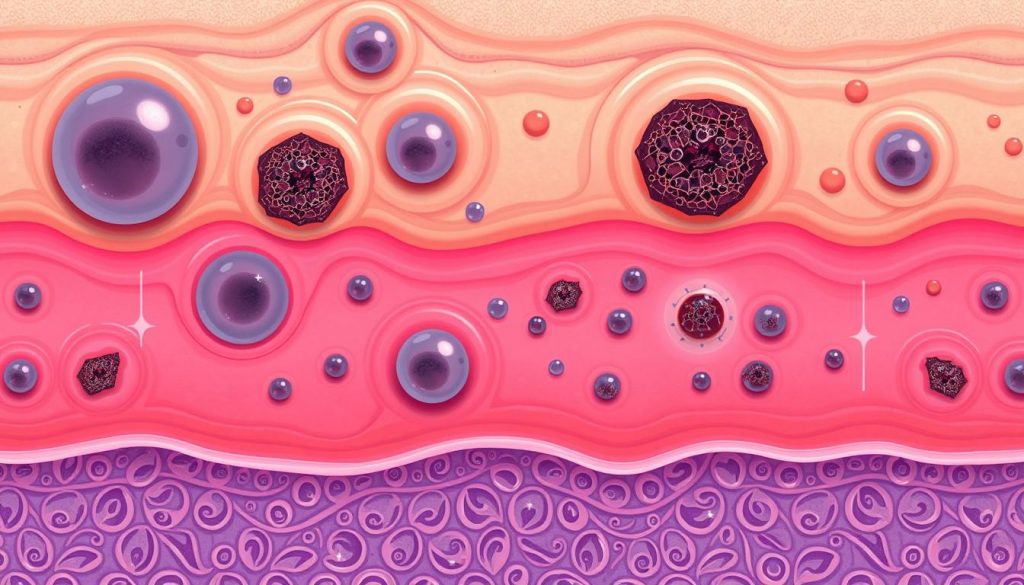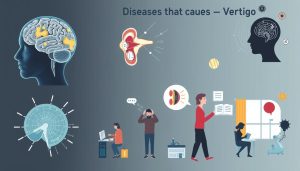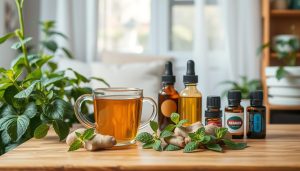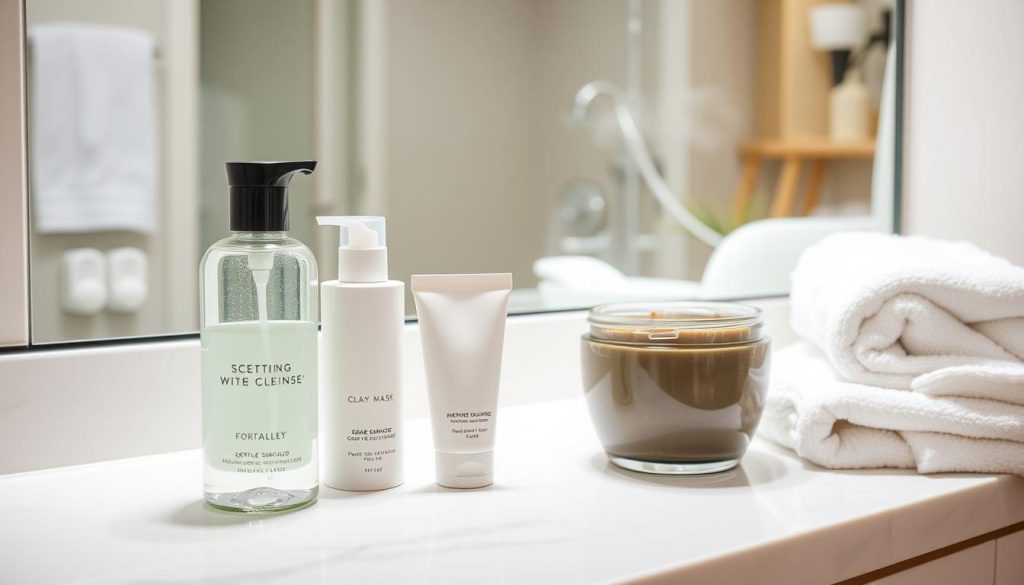Welcome to our guide on removing blackheads. If you’re asking, “how do you remove blackheads?” you’re not alone. Millions want clear skin that looks smooth and radiant. Removing blackheads is key to good skin health.
In this guide, we’ll cover many ways to get rid of blackheads. You’ll learn about home remedies and professional treatments. Our goal is to help you feel confident with your clear, healthy skin.
First, let’s talk about what blackheads are and why they appear. We’ll share effective ways to get rid of them for good. You’ll learn about daily skincare routines and the latest in dermatology. Every method is designed to help you achieve your best skin yet.
Understanding Blackheads and Their Causes
Blackheads, also known as open comedones, are small, dark spots on the face. They are a common skin issue. Knowing what causes them is key to getting rid of them. This section will explain blackheads, their causes, and how skin type affects them.
Learning about blackheads and their causes can help you find the best ways to remove them. You can find more information on tips for removing blackheads online.
What Are Blackheads?
Blackheads happen when pores get blocked by sebum and dead skin cells. When exposed to air, the blockage turns black. This makes blackheads different from whiteheads, which stay closed and don’t turn color.

Common Causes of Blackheads
- Hormonal changes that increase oil production in the skin
- Improper skin cleansing which allows oil buildup
- Excessive use of cosmetic products
- Environmental pollutants and irritants
The Role of Skin Type and Blackhead Formation
Different skin types are more prone to blackheads. For example, oily skin has more sebum, making it easier for blackheads to form. Dry or normal skin might have fewer blackheads but can’t avoid them completely. Here’s a comparison:
| Skin Type | Tendency for Blackheads | Recommended Care |
|---|---|---|
| Oily Skin | High | Daily cleansing and regular exfoliation |
| Normal Skin | Moderate | Mild cleansing and occasional exfoliation |
| Dry Skin | Low | Gentle cleansing and moisturizing to avoid over-drying |
Knowing your skin type helps you tailor your skincare routine. This way, you can prevent and reduce blackheads. Personalized tips for removing blackheads can be very helpful.
How Do You Remove Blackheads: Proven Techniques
Keeping your skin clear is key. Knowing the best blackhead removal methods is vital. This part explores blackhead extraction techniques that work well at home and in salons.
- Manual Extractors: Skincare experts use metal tools to carefully pull out blackheads. This helps avoid hurting your skin.
- Topical Retinoids: These vitamin A products clear pores and stop new blackheads from forming.
- Chemical Peels: A light peel with salicylic or glycolic acid can deep clean pores and remove dead skin.
If you’re trying to remove blackheads at home, it’s important to use tools and products right. This way, you avoid harming your skin. Below is a table that shows popular methods for removing blackheads at home and in salons.
| Method | Setting | Effectiveness |
|---|---|---|
| Salicylic acid cleansers | Home | High |
| Metal comedone extractor | Professional/Home | Medium to High |
| Microdermabrasion | Professional | High |
Choosing the right method for removing blackheads is important. Talking to a skincare expert can help you pick the best blackhead removal methods for your skin.
Also, mixing professional treatments with home care can greatly improve your skin’s health. It helps prevent blackheads from coming back.
The Importance of a Daily Skincare Routine
Keeping your skin healthy and clear starts with a daily skincare routine. Steps like cleansing, exfoliating, and moisturizing are key. They help prevent blackheads and improve your skin’s look and health.
Cleansing: The First Step to Clear Skin
Cleansing your skin every day is vital. It removes dirt, oils, and impurities that can clog pores. Use a gentle, non-comedogenic cleanser twice a day for a clean face.
Exfoliation: How Often and What to Use
Exfoliating is important for removing dead skin cells that block pores. How often you exfoliate depends on your skin type. Use a gentle exfoliator 2-3 times a week. Choose products that work well without harming your skin.
Moisturizing to Protect and Hydrate
Moisturizing keeps your skin hydrated and protected. It prevents dryness and flakiness. For those with blackheads, use lightweight, oil-free moisturizers to hydrate without clogging pores.
| Daily Routine Step | Product Recommendations | Application Tips |
|---|---|---|
| Cleansing | Gentle foaming cleanser | Use lukewarm water, massage onto face in a circular motion, rinse thoroughly |
| Exfoliation | Hydroxy acid-based exfoliator | Apply even layer, avoid aggressive scrubbing, rinse off after a few minutes |
| Moisturizing | Oil-free moisturizer | Apply while skin is stil damp to lock in moisture |
Home Remedies for Blackhead Removal
Using home remedies for blackheads is a gentle and effective way to clear your skin. It’s perfect if you’re looking for non-invasive, affordable options. We’ll look at DIY blackhead masks and natural ingredients that keep your skin healthy. We’ll also talk about important safety precautions.
Natural Ingredients That Combat Blackheads
Many natural ingredients are safe and effective against blackheads. Honey acts as a natural antibiotic, helping to clear pores. Cinnamon improves circulation and exfoliates the skin. A paste made from honey and cinnamon can reduce blackheads and make your skin smoother.
DIY Blackhead Removal Masks
- Honey and Milk Mask: Mix one tablespoon of organic honey with one teaspoon of milk. Apply the paste over your face, let it dry for 15 minutes, then gently peel off. This mask is great for removing blackheads and softening the skin.
- Egg White Mask: Egg whites can tighten pores, which may help reduce blackheads. Apply a thin layer of egg white over your face, place tissue paper on top, and after the first layer dries, apply a second layer. Peel off once completely dry.
Precautions When Using Home Remedies
DIY blackhead masks and natural ingredients are generally safer than chemical treatments. But, it’s important to patch test any homemade solution on a small area of your skin before applying it to your face. This helps avoid allergic reactions or irritation. If you have sensitive skin, it’s best to consult a dermatologist before trying any new skin care regime, including home remedies.
Over-The-Counter Solutions for Blackhead Removal
Looking for a good over-the-counter blackhead treatment can really help. Many people find success with products that have salicylic acid and benzoyl peroxide. These ingredients are known for their ability to fight blackheads.
Salicylic acid works by going deep into pores. It breaks down sebum and dead skin cells. This helps clear blackheads and stops them from coming back. Benzoyl peroxide, on the other hand, kills bacteria that cause acne. It’s great for skin that’s prone to blackheads.
When picking an over-the-counter treatment, look at the ingredients and how much is in them. Here’s a quick guide:
| Ingredient | Properties | Typical Concentrations |
|---|---|---|
| Salicylic Acid | Deeply penetrates pores to dissolve blockages | 0.5% to 2% |
| Benzoyl Peroxide | Kills acne-causing bacteria, reduces inflammation | 2.5% to 10% |
Using products with both salicylic acid and benzoyl peroxide can be very effective. Start with a low dose to see how your skin reacts. Then, you can slowly increase the amount if needed.
With regular use, these treatments can make your skin look clearer and healthier. You might not need to see a doctor for blackhead treatments. Just remember to also take care of your skin with a good routine.
Best Blackhead Removal Methods: Tools and Products
This section looks at the top ways to get rid of blackheads. We’ll explore the best tools and products out there. Each one has its own benefits and things to watch out for.
Blackhead Extraction Tools: Safe Usage
Blackhead extraction tools are at the top for removing blackheads directly. Used right, they can clear blackheads without harming your skin. It’s important to keep them clean and use gentle pressure to avoid hurting your skin.
Topical Treatments That Work
Topical treatments for blackheads often have ingredients like salicylic acid or benzoyl peroxide. These help open pores and stop blackheads from forming. Using these treatments regularly can make your skin look better and reduce acne.
Pore Strips: Benefits and Drawbacks
Pore strips are a fast way to get rid of blackheads. They stick to your skin and pull out blackheads when you remove them. But, how well they work depends on your skin and how bad the blackheads are.
| Method | Description | Pros | Cons |
|---|---|---|---|
| Extraction Tools | Metal tools used to manually remove blackheads | Precise, immediate results | Requires careful handling to avoid skin damage |
| Topical Treatments | Creams or serums applied to the skin | Addresses underlying skin issues | Results may take time to appear |
| Pore Strips | Adhesive strips that pull blackheads from pores | Quick and satisfying results | May not work on deeply embedded blackheads |
Professional Blackhead Removal: What to Expect
When you look for professional blackhead removal, knowing what to expect is key. Many people choose these services after a dermatologist’s advice. They look for dermatologist recommended blackhead treatments for safety and results.
A professional session starts with a detailed skin check. Experts figure out how bad the blackheads are and what your skin type is. This is important because it helps them create a treatment plan just for you. Here’s what usually happens during a session:
- Cleansing your skin to get rid of makeup, dirt, and oils.
- Using steam to open up your pores and soften blackheads, making them easier to take out.
- Applying special tools like comedone extractors to safely remove blackheads without harming your skin.
- Putting on a soothing mask after extraction to calm your skin and reduce redness.
Unlike home treatments, professional blackhead removal is done in a clean environment. This lowers the chance of infection or scarring. After the treatment, experts might suggest certain products or treatments to stop blackheads from coming back.
| At-Home Treatment | Professional Treatment |
|---|---|
| Limited to topical products | Comprehensive, including manual extractions |
| Risk of improper use | Conducted by trained professionals |
| May lead to skin irritation | Tailored to your specific skin type |
In short, dermatologist recommended blackhead treatments through professional removal offer quick results. They also have a long-term plan to keep your skin clear and healthy. This makes them a great choice for those who want to keep their skin in top shape.
Blackhead Extraction Techniques Demonstrated
Learning how to safely remove blackheads is key to keeping your skin healthy and clear. This guide shows you how to do it right, avoiding damage and infection. Knowing when to get help and how to care for your skin after removal is also important.
Step-by-Step Guide to Safe Extraction
Start with clean skin, using a gentle cleanser. This gets your pores ready for the extraction. Use a sterile extractor to gently press around the blackhead. Be careful not to press too hard to avoid scars.
For tough blackheads, try a warm compress first. It can help loosen them up.
When to See a Professional for Extractions
If you feel pain or see a lot of redness, stop and see a dermatologist. They can do safe extractions without risks. They also give advice based on your skin type.
Aftercare Following Blackhead Extraction
Good aftercare is key to healing and keeping your skin clear. Use an antiseptic solution to prevent infection. Then, apply a soothing moisturizer and sunscreen to protect your skin.
Exfoliating regularly can also help prevent new blackheads.
| Step | Action | Benefit |
|---|---|---|
| 1 | Cleansing | Prepares skin by removing impurities and opening pores. |
| 2 | Applying Warm Compress | Softens the blackheads, making them easier to extract. |
| 3 | Using Comedone Extractor | Provides a safe method for extraction, minimizing skin damage. |
| 4 | Applying Antiseptic | Prevents infection post-extraction. |
| 5 | Moisturizing and Protecting | Calms the skin and shields against environmental damage. |
Preventing Blackheads: Tips and Tricks
To keep your skin clear and prevent blackheads, you need to take care of your skin and make some lifestyle changes. Here are some tips and tricks for preventing blackheads and keeping your skin clear.
- Maintain a regular cleansing routine using products suitable for your skin type.
- Exfoliate your skin gently but consistently to remove dead skin cells and prevent pore clogging.
- Stay hydrated both internally by drinking plenty of water and externally by using appropriate moisturizers.
- Adopt a balanced diet rich in antioxidants and vitamins to support skin health.
Having a good skincare routine is key to preventing blackheads. You can adjust it to fit your skin type and lifestyle. Here’s a comparison of important skincare components for clear skin.
| Component | Function | Recommended Frequency |
|---|---|---|
| Cleansing | Removes dirt and excess oils from the skin | Twice daily |
| Exfoliating | Clears away dead skin cells | 2-3 times a week |
| Moisturizing | Hydrates and protects the skin | Daily |
| Face Masks | Deep cleansing and nutrition | Once a week |
Following these routines can help prevent blackheads and improve your skin’s health. It leads to long-term clear skin maintenance. For more tailored advice, talk to a dermatologist to meet your specific skin needs.
Dermatologist Recommended Blackhead Treatments
Getting clear skin is easier with a dermatologist’s help and special treatments. For those with tough blackheads, a professional touch is key. We’ll look at dermatologist treatments for blackheads, from topicals to in-office procedures, for lasting results.
Medical-Grade Topicals and Their Effectiveness
Medical-grade topicals lead the way in treating blackheads. They have strong ingredients like retinoids, salicylic acid, and benzoyl peroxide. These ingredients go deep into the skin to clear pores. A dermatologist will choose the right one for you based on your skin.
In-Office Procedures for Persistent Blackheads
For blackheads that don’t go away with creams, dermatologists suggest in-office treatments. These include professional extractions, microdermabrasion, or chemical peels. These methods remove the top skin layer to clear pores and improve skin texture. They’re done safely in a controlled setting.
Long-Term Strategies for Blackhead-Free Skin
Keeping your skin blackhead-free takes more than just treatments. It’s about a good skincare routine and healthy lifestyle choices. Dermatologists recommend using non-comedogenic products, exfoliating regularly, and eating well to stop blackheads from coming back.
Let’s see how these strategies work by comparing common treatments:
| Treatment Type | Primary Benefit | Suggested Frequency |
|---|---|---|
| Medical-Grade Topicals | Targeted treatment for deep pore cleansing | Daily as prescribed |
| In-Office Procedures | Immediate results for persistent blackheads | Every 4-6 weeks |
| Lifestyle Adjustments | Long-term prevention of blackheads | Ongoing |
How Diet and Lifestyle Affect Blackhead Formation
Looking into the impact of diet on blackheads shows how our food choices affect our skin. This part explains how some foods and habits can help or hurt our skin, including blackheads.
The link between diet and skin health is clear. Foods with lots of sugar and dairy can make skin problems worse, like blackheads. On the other hand, eating foods full of antioxidants, like fruits and veggies, can protect the skin and lower blackhead chances.
- Eating oily and fried foods can make skin produce more sebum, leading to more blackheads.
- Drinking lots of water helps clean the skin and open pores.
- High-fiber foods help with digestion and might prevent pores from getting clogged.
But diet isn’t the only thing that matters. Lifestyle factors also play a big role. Exercise helps by making us sweat, which cleans pores. But stress can make skin problems worse, including more blackheads.
Changing your lifestyle for better skin doesn’t have to be hard. Simple actions like eating well, exercising, and drinking water can make a big difference. These habits not only improve health but also make skin look clearer.
Learning how lifestyle affects skin health helps us make better choices. This can lead to fewer blackheads and healthier, brighter skin.
The Psychology of Skin: Impact of Stress on Blackheads
Stress and skin health are closely linked. Emotional and mental wellbeing can greatly affect our skin, leading to blackheads. Knowing this helps us find ways to reduce stress for better skin.
Understanding the Skin-Stress Connection
Stress makes our skin produce more oil. This excess oil can block pores and cause blackheads. It also makes our skin harder to heal, worsening any skin problems.
Stress-Reduction Techniques for Better Skin Health
Reducing stress can greatly improve our skin. Yoga, meditation, and exercise are great for lowering stress. They help prevent skin problems like blackheads.
When to Seek Professional Help for Skin-Related Stress
If skin problems don’t get better, see a dermatologist or psychodermatologist. They can help with both the mental and physical sides of stress-related skin issues.
| Technique | Benefits | Recommended Frequency |
|---|---|---|
| Yoga | Reduces cortisol, improves complexion | 2-3 times per week |
| Meditation | Enhances skin healing, reduces stress | Daily |
| Physical Exercise | Increases blood flow, decreases stress | 3-5 times per week |
Using these stress-reduction techniques can greatly improve your skin. It can help reduce blackheads and make your skin look healthier and more radiant.
Advanced Skincare Technologies in Blackhead Removal
Using advanced skincare technologies can change how we fight blackheads. Laser treatment and microdermabrasion are now top choices. They are known for working well and having little downtime.
Laser treatment is precise and goes deep into the skin. It clears pores and cuts down on sebum. This method gets rid of blackheads and stops new ones from forming. Microdermabrasion, on the other hand, is gentler. It uses a special tool to remove the top skin layer, helping to grow new, smooth skin.
Both methods work well on different skin types. But, they might not be right for everyone. The table below shows what to think about when picking a treatment for blackheads.
| Technology | Description | Skin Suitability |
|---|---|---|
| Laser Treatment | Uses focused light therapy to penetrate the skin, facilitating deep cleansing and rejuvenation. | Most effective for oily and acne-prone skin. |
| Microdermabrasion | Employs mechanical exfoliation to remove dead skin cells and stimulate new cell growth. | Suitable for most skin types, including sensitive skin. |
Before trying these advanced skincare technologies, talk to a dermatologist. They can help choose the best option for your skin. This ensures the best results and avoids any bad side effects.
Treating Blackheads in Sensitive Skin Areas
Dealing with blackheads in sensitive spots like the eyes and lips needs care. Sensitive skin blackhead treatment is about being effective yet gentle. It’s important to keep the skin’s barrier strong while removing blackheads.
Choosing the right products is key. Look for products made for sensitive skin. They should be free from harsh chemicals and fragrances that can irritate.
The way you remove blackheads matters too. Instead of using force, use soft pressure and gentle tools. Tools like non-abrasive exfoliants and hydroxy acids at low concentrations are good. Also, using a topical retinoid, as advised by a dermatologist, helps prevent blackheads without harming sensitive areas.
After treating blackheads, apply a soothing moisturizer to hydrate and repair the skin. Protecting the skin from the sun is also vital. Use a mineral-based sunscreen to avoid irritation. With these steps, you can safely treat blackheads in sensitive areas.
FAQ
Q: What are blackheads and why is it important to remove them?
A: Blackheads are small dark spots on the skin caused by clogged hair follicles. They are a type of acne called open comedones. It’s key to remove them to keep your skin clear, prevent pimples, and keep pores open.
Q: What causes blackheads to form?
A: Blackheads form when sebum and dead skin cells block hair follicles. Hormonal changes, too much oil, and bad skincare routines can cause them. Oily skin is more likely to get blackheads.
Q: What are some effective blackhead removal techniques?
A: Good ways to remove blackheads include gentle exfoliation and using treatments with salicylic acid or benzoyl peroxide. Professional extraction and using pore strips or tools are also effective, but follow the instructions.
Q: How does a daily skincare routine prevent blackheads?
A: A daily skincare routine that cleanses, exfoliates, and moisturizes keeps your skin clean. It removes dead skin cells and balances oils, helping prevent blackheads.
Q: Can you recommend some home remedies for blackhead removal?
A: Yes, using baking soda, apple cider vinegar, and clay masks can help remove blackheads. DIY masks with honey and oatmeal are also good. But always do a patch test first to avoid irritation.
Q: What over-the-counter products work well for blackheads?
A: Products with salicylic acid, benzoyl peroxide, and alpha-hydroxy acids are great for blackheads. They clean pores and exfoliate, helping prevent and treat blackheads.
Q: How do blackhead extraction tools work, and are they safe to use?
A: Blackhead extraction tools apply gentle pressure to release blackheads from the skin. It’s important to use them safely and hygienically to avoid damage and infections.
Q: What should I expect with professional blackhead removal?
A: Professional blackhead removal involves a dermatologist using sterile tools to extract blackheads gently. Treatments may include peels, masks, or other professional recommendations.
Q: How can I ensure safe blackhead extraction at home?
A: To safely extract blackheads at home, start with clean skin and tools. Use gentle pressure and avoid squeezing too hard. Aftercare, like applying a toner and moisturizer, is also important.
Q: What are some tips for preventing blackheads from forming?
A: To prevent blackheads, keep a regular skincare routine and avoid comedogenic products. Keep hair and hands away from your face and manage oil through diet and skincare. Regular exfoliation also helps.
Q: What dermatologist-recommended treatments are available for blackheads?
A: Dermatologists might suggest retinoids, chemical peels, or manual extractions for blackheads. For severe cases, they might recommend prescription-strength treatments or in-office procedures.
Q: How do diet and lifestyle affect the formation of blackheads?
A: Diet and lifestyle can impact blackheads by affecting hormones and oil production. A diet high in sugars and dairy can worsen acne. Stress also affects skin health. Regular exercise, a balanced diet, and stress management can help.
Q: What is the connection between stress and blackheads?
A: Stress can increase hormones that lead to more oil production, causing blackheads. Managing stress through mindfulness, exercise, or counseling can improve skin health.
Q: What advanced skincare technologies help with blackhead removal?
A: Technologies like laser therapy and microdermabrasion can remove blackheads by exfoliating and reducing oil. They improve skin texture. Talk to a skincare specialist to find the best option for your skin.
Q: How should I treat blackheads in sensitive skin areas?
A: Treat blackheads in sensitive areas gently, avoiding harsh scrubbing or squeezing. Use mild exfoliants, hydrating masks, and non-comedogenic moisturizers. For delicate areas, consult a dermatologist.
Go to the full page to view and submit the form.









